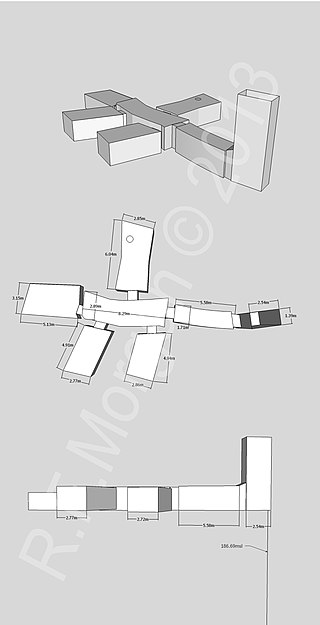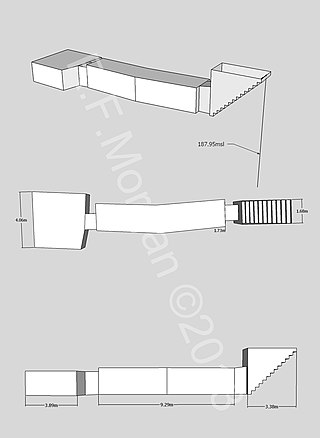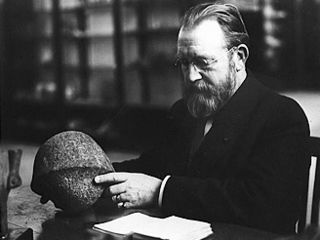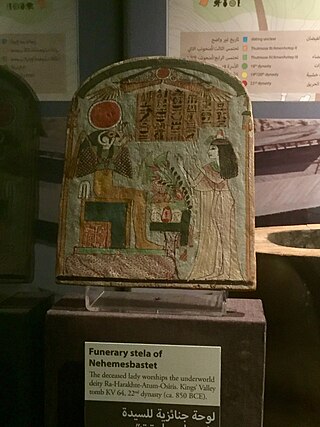Related Research Articles

Tomb KV26 is an ancient Egyptian tomb of the Eighteenth Dynasty located in Egypt's Valley of the Kings. It is located in a side valley leading to the tomb of Thutmose III (KV34). It was visited by the early Egyptologist James Burton in the 1820s or 1830s, and by Victor Loret in 1898. It was mapped in the 1980s by the Theban Mapping Project. The first documented excavation of the tomb was carried out in 2009 by the University of Basel's Kings' Valley Project. The tomb contained evidence of at least one burial and fragmented pottery and stone vessels of mid-Eighteenth Dynasty date but nothing is known about its occupant(s).

Tomb KV30 is an ancient Egyptian tomb located in the Valley of the Kings in Egypt. It likely dates to the mid-Eighteenth Dynasty and was used for the burial of an unknown individual. It may have been discovered by Giovanni Belzoni in 1817, working on a commission from the Second Earl Belmore. It was excavated in 2009-2010 by the University of Basel's Kings' Valley Project.
Tomb KV29 is an ancient Egyptian tomb in the Valley of the Kings, in the Theban Necropolis of Egypt. It is located near the mid-Eighteenth Dynasty tombs of Tiaa (KV32), Thutmose II or Merytre-Hatshepsut (KV42), and Thutmose III (KV34). The tomb was known since the 1830s and given the number KV29 in 1899 but no records of an earlier excavation exist. The entrance shaft was previously planned by the Theban Mapping Project in the 1990s. The tomb was first excavated by the University of Basel King's Valley Project in 2011. Excavation continued in 2016 but the rest of the tomb is filled with debris and its layout is unknown.
Tomb KV33 is an ancient Egyptian tomb in the Valley of the Kings in Egypt. It is located close to the tomb of Thutmose III, KV34. The tomb dates to the mid-Eighteenth Dynasty and was used for the burial of an unknown individual. The layout is simple, consisting of descending steps and a main chamber with two adjoining rooms. KV33 was discovered by Victor Loret in 1898. The small tomb was open to visitors in the early 1900s when it was described in a tourist guidebook. In modern times, a bench was built over the entrance. In 2012 the tomb was excavated for the first time by the University of Basel's Kings' Valley Project.

Tomb KV37 is an ancient Egyptian tomb located in the Valley of the Kings in Egypt. The presence of bone fragments and white-washed storage jars indicate that the tomb was used for a burial, probably in the Eighteenth Dynasty. However, its original occupants are unknown.

Tomb KV40 is located in the Valley of the Kings, in Egypt. Artifacts from the tomb attribute it to 18th Dynasty royal family members, though human remains from the later 22nd Dynasty were interred. Although the tomb was excavated by Victor Loret in 1899, no report was published.

KV31 is an ancient Egyptian tomb located in the Valley of the Kings, near Luxor, Egypt. Only the top of the shaft was known prior to excavation by the University of Basel Kings' Valley Project in 2010, and no earlier excavations are known, although it is suggested that the stone sarcophagus excavated by Giovanni Battista Belzoni in 1817 may have originated from this tomb. The tomb was found to be filled with mixed debris of pottery sherds and linen fragments, as well as the remains of five mummified elite individuals dating to the Eighteenth Dynasty.

Salima Ikram is a Pakistani professor of Egyptology at the American University in Cairo, a participant in many Egyptian archaeological projects, the author of several books on Egyptian archaeology, a contributor to various magazines and a guest on pertinent television programs.

KV64 is the tomb of an unknown Eighteenth Dynasty individual in the Valley of the Kings, near Luxor, Egypt that was re-used in the Twenty-second Dynasty for the burial of the priestess Nehmes Bastet, who held the office of "chantress" at the temple of Karnak. The tomb is located on the pathway to KV34 in the main Valley of the Kings. KV64 was discovered in 2011 and excavated in 2012 by Susanne Bickel and Elina Paulin-Grothe of the University of Basel.
Donald P. Ryan is an American archaeologist, Egyptologist, writer and a member of the Division of Humanities at Pacific Lutheran University in Tacoma, Washington. His areas of research interest include Egyptian archaeology, Polynesian archaeology, the history of archaeology, the history of exploration, ancient languages and scripts and experimental archaeology. He is best known for his research in Egypt including excavations in the Valley of the Kings where he investigated the long-neglected undecorated tombs in the royal cemetery. His work there resulted in the rediscovery of the lost and controversial tomb KV60, the re-opening of the long-buried KV21 with its two female and likely royal occupants, and tombs KV27, KV28, KV44, KV45 and KV48. In 2017, he rediscovered three small tombs in the Valley of the Kings which when first encountered in 1906 contained the mummies of animals including a dog and monkeys.
Carl Nicholas Reeves, FSA, is a British Egyptologist, archaeologist and museum curator.
KV65 is a tomb commencement located in the Western Valley of the Kings, near Luxor, Egypt. It was discovered in 2018 by a team led by the Egyptologist Zahi Hawass and announced in 2019. The tomb consists of a sloping rectangular pit of similar proportions to the entrances of royal tombs from the Eighteenth Dynasty. It contained a variety of items consisting of construction tools, pieces of rope, animal bones, leather, pottery, and food remains. It may represent a cache where the remains of a funerary feast and embalming material was buried, similar to the embalming cache of Tutankhamun, KV54.

Jean Capart was a Belgian Egyptologist, who is often considered the "Father of Belgian Egyptology."
Tasos Neroutsos was a Greek physician and scholar.

Nehmes Bastet or Nehemes-Bastet was an Ancient Egyptian priestess who held the office of "chantress"; she was the daughter of the high priest of Amun. She lived during the Twenty-second Dynasty and was buried in tomb KV64 in the Valley of the Kings. It was excavated in 2012 and discovered to be a reuse of a tomb for the burial of a woman of an earlier dynasty, whose name, as yet, is unknown.

Johann Christoph "Jan" Assmann is a German Egyptologist.
Henning Franzmeier is a German archaeologist and Egyptologist with the Roemer- und Pelizaeus-Museum Hildesheim and University College London (UCL). Taking over from Edgar B. Pusch he has been field director of the "Qantir-Piramesse Project" in Egypt's Nile Delta since 2015, where Pi-Ramesses, the capital of Ramesside Egypt is being unearthed.
Thomas Schneider is a German Egyptologist.

Antonio Loprieno is a Swiss Italian Egyptologist and Professor of History of Institutions at the University of Basel. From 2005 to 2015, he was rector of the University of Basel. He was also president of the Rectors’ Conference of the Swiss Universities (CRUS) from 2008 to 2015. Since 2018, he has been president of ALLEA, the European Federation of Academies of Sciences and Humanities, and of the Swiss Academies of Arts and Sciences. From December 2019 to December 2020, he was president of the Jacobs University Bremen.
References
- ↑ www.religionswissenschaft.uzh.ch
- ↑ Spieckermann, Hermann (2006). Götterbilder, Gottesbilder, Weltbilder. Mohr Siebeck. p. 79. ISBN 978-3-16-148673-9 . Retrieved 25 November 2011.
- ↑ Susanne Bickel, Princesses, Robbers, and Priests - The unknown side of the Kings' Valley, Presentation at a conference at the Museo Egizio in Turin, Italy, 14 October 2017, Online; KV 64 is discussed at 27:30 onward
- ↑ Rühli, Frank; Ikram, Salima; Bickel, Susanne (2015). "New Ancient Egyptian Human Mummies from the Valley of the Kings, Luxor: Anthropological, Radiological, and Egyptological Investigations". BioMed Research International. 2015: 530362. doi: 10.1155/2015/530362 . PMC 4544442 . PMID 26347313.
- ↑ S. Bickel & E. Paulin-Grothe, "KV 64: two burials in one tomb," Egyptian Archaeology, vol. 41, pp. 36–40, 2012.
- ↑ "New archaeological discovery at the Valley of the Kings – Ancient Egypt – Heritage – Ahram Online". english.ahram.org.eg. Retrieved 26 February 2018.